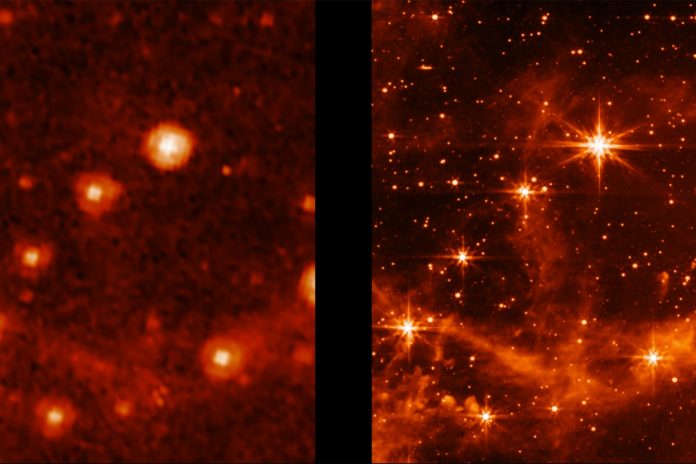The James Webb Space Telescope continues to calibrate its instruments before launching into space in search of the so-called first light of the universe , that flash emitted about 13.7 billion years ago, just 100 million years after the Big Bang, in a region of the universe that so far has not been explored.
NASA
For those who can’t wait to see the images that the space telescope will send to Earth, NASA has released a short video demonstrating the sharpness of the images that an instrument called MIRI ( Mid-Infrared Instrument ) can capture. a camera and a spectrograph capable of capturing wavelengths that are longer than our eyes can see. The video allows you to compare an image taken by the Spitzer Space Telescope and one from the James Webb Space Telescope of the Large Magellanic Cloud , a dwarf galaxy, a satellite of the Milky Way.
The comparison is surprising and can be seen in a tweet published by the telescope’s official account with the following caption: “Computer, improve! Compare the same target, seen by Spitzer and in Webb’s calibration images. Spitzer, NASA’s first Large Infrared Observatory, paved the way for Webb’s larger primary mirror and improved detectors to see the infrared sky even more clearly.”
Computer, enhance! Compare the same target—seen by Spitzer & in Webb’s calibration images. Spitzer, NASA’s first infrared Great Observatory, led the way for Webb’s larger primary mirror & improved detectors to see the infrared sky with even more clarity: https://t.co/dIqEpp8hVi pic.twitter.com/g941Ug2rJ8
— NASA Webb Telescope (@NASAWebb) May 9, 2022
The James Webb Observatory is considered the successor to the Hubble and Spitzer Space Telescopes. Although the probe was launched on December 25, 2021, the project began more than 20 years ago and involves NASA, the European Space Agency (ESA) and the Canadian Space Agency. The James Webb probe will begin its space observation in the summer of 2022. It is estimated that the mission of this sophisticated device will last five to ten years.

